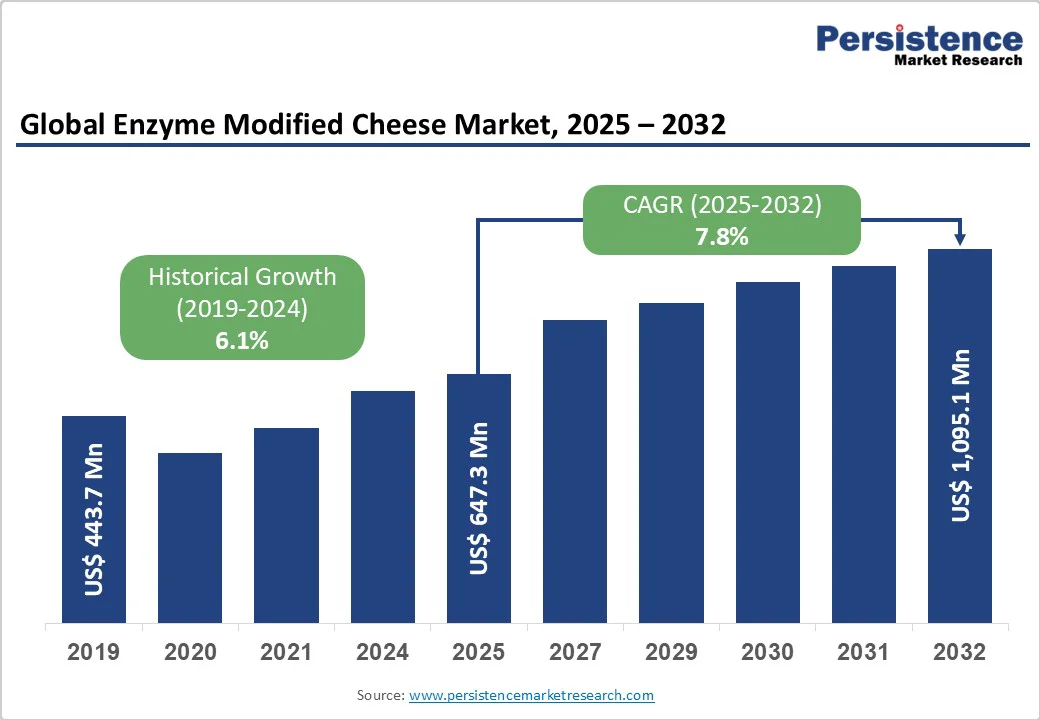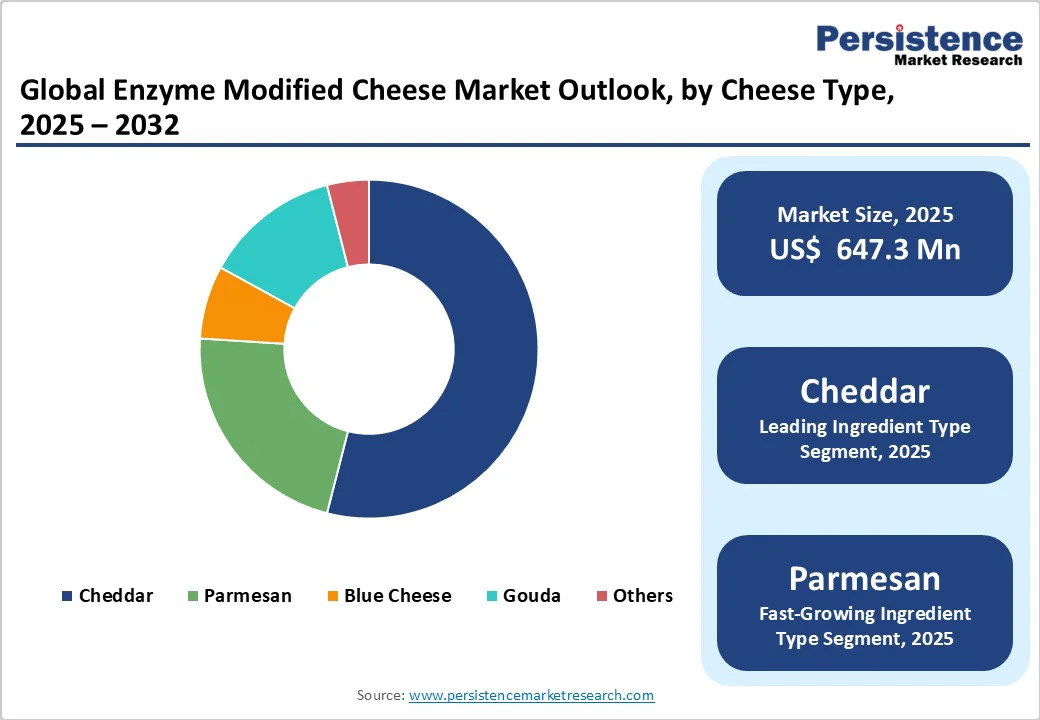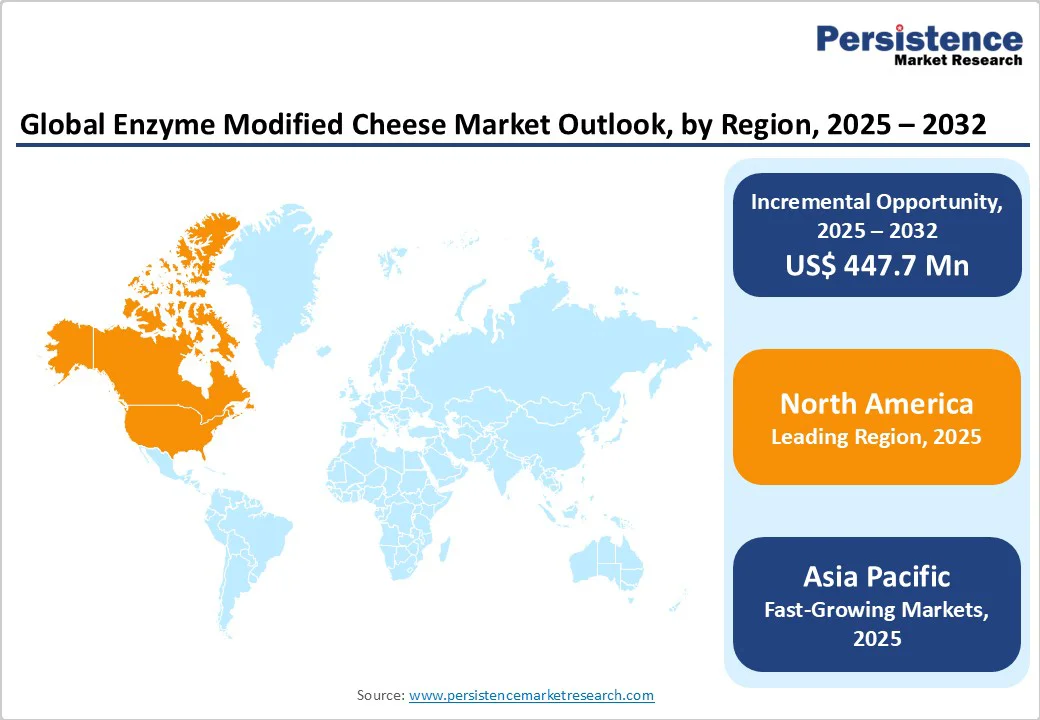ID: PMRREP22609| 190 Pages | 29 Sep 2025 | Format: PDF, Excel, PPT* | Food and Beverages

The global enzyme modified cheese market size is likely to value at US$ 647.3 Mn in 2025 and is projected to reach US$ 1,095.1 million by 2032, growing at a CAGR of 7.8% during the forecast period from 2025 to 2032. The enzyme modified cheese market is an emerging segment of the food and beverage industry, driven by innovative enzymatic processes that enhance cheese flavor, texture, and functionality.
| Key Insights | Details |
|---|---|
|
Enzyme Modified Cheese Market Size (2025E) |
US$ 647.3 Mn |
|
Market Value Forecast (2032F) |
US$ 1,095.1 Mn |
|
Projected Growth (CAGR 2025 to 2032) |
7.8% |
|
Historical Market Growth (CAGR 2019 to 2024) |
6.1% |

One of the strongest growth catalysts for the global enzyme modified cheese (EMC) market is the increasing consumer preference for bold, authentic cheese flavors in everyday processed foods. Modern consumers are seeking indulgence and familiarity in convenient formats such as frozen pizzas, pasta sauces, cheese dips, and savory snacks. EMC technology enables manufacturers to achieve a flavor intensity 10 to 20 times stronger than natural ripened cheese, providing the depth and authenticity that traditional formulations often lack. Beyond flavor strength, EMC offers functional versatility delivering consistent taste even under high-heat or long-shelf-life conditions.
An illustrative example is Edlong Flavor Solutions, which develops EMC-based dairy flavors that replicate distinct cheese varieties, from sharp cheddar to creamy mozzarella, for applications in sauces and ready meals. By using EMC, brands can elevate processed food lines with gourmet-style flavor experiences while reducing overall cheese content, making products both cost-efficient and consumer-appealing.
Global expansion of enzyme modified cheese (EMC) faces a critical hurdle of inconsistent food regulations that complicate formulation and commercialization. While EMC delivers concentrated cheese flavor, its classification differs widely by region, forcing manufacturers to adapt recipes and labeling. In the European Union, the European Food Safety Authority (EFSA) enforces strict rules on enzyme use and flavoring declarations, demanding extensive safety evidence before approval. By contrast, the U.S. Food and Drug Administration (FDA) recognizes EMC as a flavor ingredient, but mandates labeling that can affect consumer perception.
Across Asia and Latin America, further regulatory variations increase compliance burdens. This fragmented oversight delays product launches, raises operating costs, and restricts the ability of global producers to standardize EMC offerings, making regulatory complexity a persistent restraint on the market’s growth potential.
In the global enzyme modified cheese (EMC) market, innovating formulations to enhance processed food stability represents a high-value opportunity for leading players. EMC inherently delivers concentrated flavor and functional properties, but its application in processed foods can be constrained by moisture migration, fat separation, or textural inconsistencies during storage and thermal processing.
By developing EMC variants with optimized enzyme blends, tailored protein interactions, and controlled moisture retention, manufacturers can significantly improve the stability, consistency, and shelf life of processed foods such as sauces, ready-to-eat meals, and cheese spreads. This not only reduces product waste but also enhances consumer satisfaction through consistent flavor and texture. Furthermore, these innovations can enable broader adoption of EMC in frozen, canned, and packaged convenience foods, positioning suppliers as indispensable partners for food processors. Players investing in research for process-stable EMC can differentiate themselves, expand application versatility, and capture premium pricing in both mature and emerging markets, reinforcing long-term growth potential.
Cheddar EMC holds approximately 54% of the market share as of 2024, making it the most dominant segment in the global enzyme modified cheese market. Its sharp, versatile flavor profile allows it to seamlessly enhance a wide range of processed foods, including sauces, snacks, ready-to-eat meals, and baked products. Unlike Parmesan or Blue Cheese EMC, which cater primarily to niche or gourmet applications, Cheddar EMC offers broad industrial applicability, making it the preferred choice for food manufacturers seeking consistent taste and functional performance. Additionally, its compatibility with thermal processing, shelf-life stability, and adaptability in various formats, powder, and paste further reinforce its dominance. The strong global demand for processed and convenience foods continues to drive Cheddar EMC adoption, positioning suppliers that specialize in this variant for sustained growth and strategic partnerships with major food processors worldwide.
Powder EMC holds approximately 65% of the market share as of 2024, establishing it as the leading form in the global enzyme modified cheese market. Its dominance is driven by versatility, ease of handling, and consistent functionality across diverse food applications. Powder EMC can be precisely measured, blended, and incorporated into sauces, snacks, baked goods, and processed cheese products without affecting texture or stability. Unlike liquid, paste, or granule forms, powders offer longer shelf-life, reduced transportation costs, and simplified storage, making them highly attractive for industrial food processors. Additionally, powder EMC allows manufacturers to customize flavor intensity and solubility according to specific formulations, enhancing operational efficiency. The growing demand for convenience foods and processed culinary products globally continues to reinforce powder EMC’s leading position, making it a critical focus area for suppliers aiming to expand market share and strengthen partnerships with food manufacturers.

North America holds significant share of 39% share in the global market driven by strong demand from the U.S. processed foods, ready-to-eat meals, and snack industries, which heavily utilize enzyme modified cheese to enhance flavor, texture, and shelf-life. The region’s fast-food culture and rising consumption among Gen Z and Millennials have further accelerated EMC adoption in quick-service restaurants and convenience foods.
In 2024, food expenditures by U.S. consumers, businesses, and government entities reached $2.63 trillion, up from $2.53 trillion in 2023, according to USDA data. This increase was mainly driven by growth in food-away-from-home spending, climbing from $1.46 trillion in 2023 to $1.54 trillion in 2024. Consequently, EMC suppliers are focusing on innovative, process-stable formulations, functional variants, and convenient formats to meet evolving consumer preferences and support the booming fast-food and processed food sectors across North America.
Europe remains a key region in the global enzyme modified cheese (EMC) market, with robust demand driven by traditional cheese-loving countries such as Germany, France, Italy, and Spain. Consumers in these nations have a deep-rooted appreciation for cheese, both as a standalone product and as an ingredient in culinary applications, creating strong industrial demand for EMC to enhance flavor intensity and consistency in processed foods, sauces, and ready-to-eat meals.
Germany and France lead in industrial cheese processing, while Italy and Spain drive specialty and gourmet applications, including pasta, baked goods, and snack products. The increasing trend of convenience and pre-prepared meals across urban centers is further supporting EMC adoption. European manufacturers are innovating with tailored enzyme blends and functional formulations to meet strict food safety standards and evolving taste preferences. This positions Europe as a strategic market for EMC suppliers targeting premium, high-flavor applications.

The competitive nature of the global enzyme modified cheese market is shaped by the presence of established dairy ingredient suppliers, regional producers, and specialty cheese innovators vying for market share. Leading players focus on differentiating through product quality, formulation versatility, and the ability to cater to diverse food applications, including processed foods, ready-to-eat meals, and snacks. Innovation in process-stable EMC, functional variants, and convenient formats such as powders, pastes, and liquids has become a key strategy to meet evolving consumer preferences and regulatory requirements. Strategic partnerships with food manufacturers and investment in R&D for tailored flavor profiles further define the competitive landscape, enabling companies to strengthen positioning and capture premium segments globally.
The global market is projected to be valued at US$ 647.3 Mn in 2025.
Rising demand for strong, authentic cheese notes in processed foods drives the global enzyme modified cheese market.
The global market is poised to witness a CAGR of 7.8% between 2025 and 2032.
Innovating EMC formulations to improve processed food stability is the key market opportunity for key players.
Aromsa, Kerry Group plc., First Choice Ingredients - a DSM company, Maysa Gıda, Butter Buds Inc., The Edlong Corporation and others are some of the key players in the market.
| Report Attribute | Details |
|---|---|
|
Historical Data/Actuals |
2019 - 2024 |
|
Forecast Period |
2025 - 2032 |
|
Market Analysis |
Value: US$ Mn and Volume (MT) |
|
Geographical Coverage |
|
|
Segmental Coverage |
|
|
Competitive Analysis |
|
|
Report Highlights |
|
By Cheese Type
By Functional Modification
By Form
By End-use
By Region
Delivery Timelines
For more information on this report and its delivery timelines please get in touch with our sales team.
About Author